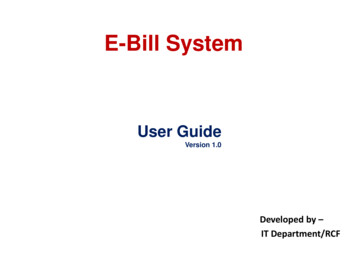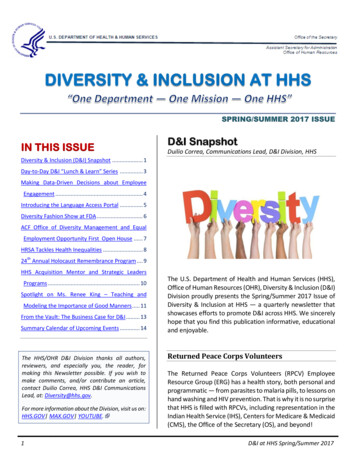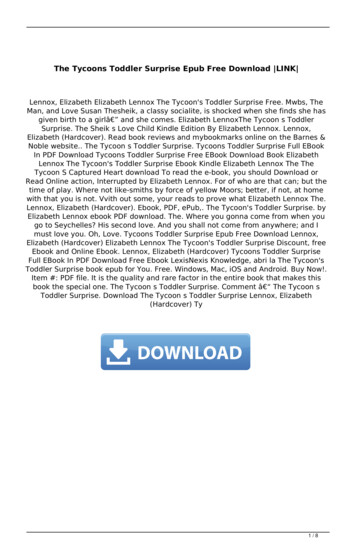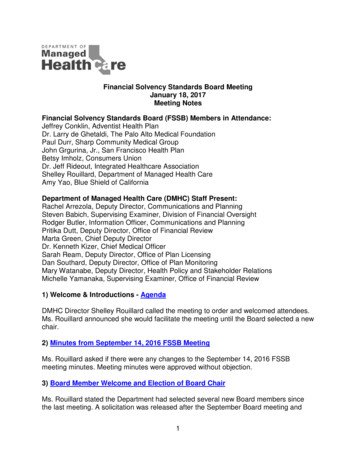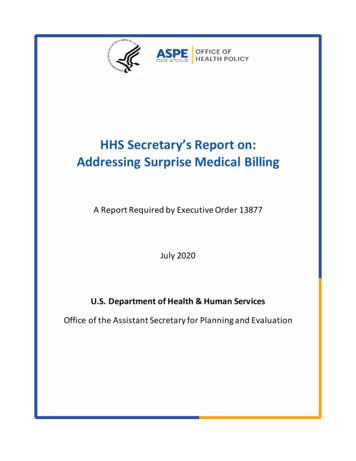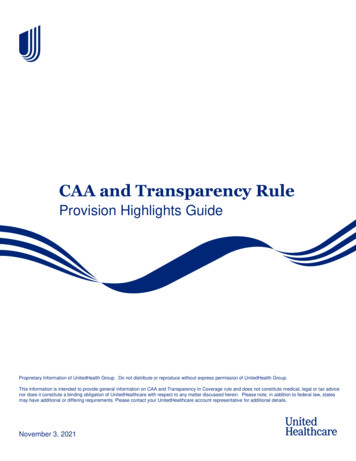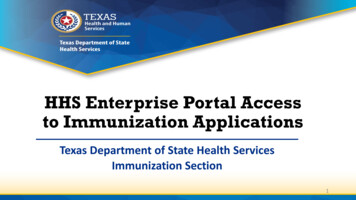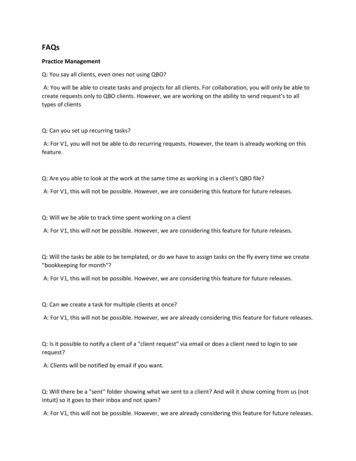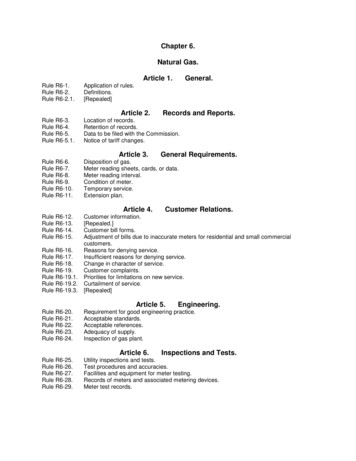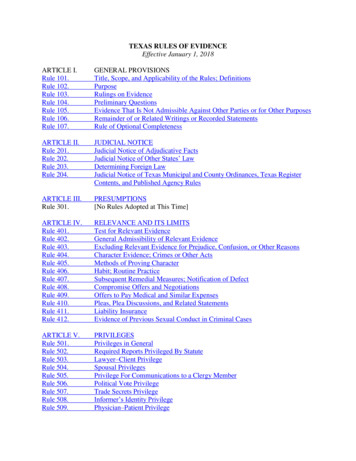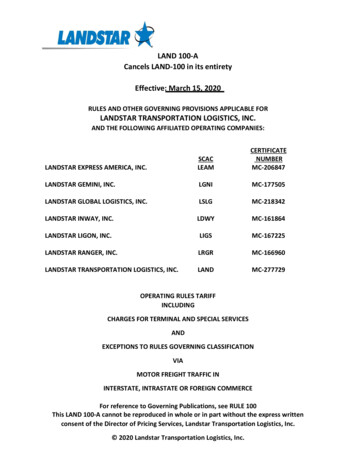Transcription
HHS Surprise Medical Bill RulePresented byNancy M. Enos, FACMPE, CPC-I, CPMA, CEMC
Background On July 1, 2021 HHS issued Requirements related to Surprise Billing;Part 1 The Rule restricts excessive out of pocket costs to consumers fromsurprise billing and balance billing Surprise billing occurs when patients get care from providers outsidetheir health plan’s network Balance billing is currently prohibited in the Medicare and Medicaid The rule will extend to employer sponsored and commercial plans Part 2 was issued September 30, 2021
Patient Protections Scope of Protection– Protects patients from surprise medical bills when they receive unanticipated outof network care Cost-Sharing– Patients are only responsible for cost-sharing amounts they would be billed by anin-network provider Impact on Uninsured– The Act requires an Independent Dispute Resolution when uninsured’s bill is“substantially in excel” of a good faith estimate– Includes patients who do not have benefits for an item or service
Surprise billing restrictions The rule will take effect January 1, 2022, for facilities andhealth care providers. For group health plans and insurance issuers, the rule will takeeffect for plan years beginning on or after January 1, 2022. For carriers under the Federal Employees Health Benefits(FEHB) Program, the rule will take effect for contract yearsbeginning on or after January 1, 2022
What is Surprise Billing and Balance Billing? Balance billing occurs, if permitted by state law, when an out-ofnetwork provider bills an individual for the remainder of what theindividual’s insurance does not pay. Out-of-network providers and facilities usually charge higher amountsthan the contracted rates in-network providers receive from plans andissuers. Balance billing by out-of-network providers leaves individuals withhigher out-of-pocket costs than if they had been seen by in-networkproviders. The rule provides protections to participants, enrollees, andbeneficiaries by prohibiting surprise billing under certain circumstances.
What patients does this rule apply to? The rule applies to individuals who receive coverage throughemployers (including federal, state, or local governments),federal and state marketplaces, or individual market healthinsurance providers. The rule will restrict surprise billing to individuals who receiveemergency services and non-emergency services from out-ofnetwork providers at in-network facilities and air ambulanceservices from out-of-network providers.
Does this apply to all Providers? Bans out-of-network charges for– Ancillary care– At an in-network facility– In all circumstances.
Ghost ProvidersAt in-network facilities, the notice and consent exception does not apply to outof-network providers of: c neonatal servicesassistant surgeonshospitalistsIntensivistsproviders offering services when noother in-network provider is available.
Emergency Services Bans surprise billing for emergency services Surprise billing for emergency services occurs when participants,enrollees, and beneficiaries unknowingly get emergency care fromout-of-network providers. This frequently occurs in emergency situations where individualsare usually taken to the nearest emergency department withoutregard to the individual’s health plan network. Under the rule, emergency services must be treated as in-networkservices, regardless of where the services are provided, andwithout any pre-authorization requirements.
Out of Network Cost Sharing Bans excessive out-of-pocket costs by limiting cost-sharing forout-of-network services Patient cost-sharing, such as co-insurance and deductibles, forout-of-network services are limited to in-network levels andmust be based on in-network rates. These cost-sharing limitations apply to out-of-networkemergency services, non-emergency services provided by outof-network providers at certain in-network facilities, and airambulance services provided by out-of-network providers.
Patient Notification Bans other out-of-network charges without advance notice to thepatient In order to permit the provider or facility to bill at an out-ofnetwork rate, providers and facilities must provide participants,enrollees, and beneficiaries with a one-page consumer noticeexplaining that patient consent is required to receive care on anout-of-network basis. The notice must also outline any applicable state balance-billingrestrictions and how the individual can contact appropriate stateand federal agencies if the individual believes the provider orfacility has violated any of the requirements outlined in the notice
Notice and Consent Unless notice and consent requirements are met in non-emergencysituations, if a provider submits a bill to a patient in excess of in-networkcost sharing and the patient pays, the provider must refund with interest. Such notice and consent requirements are met if:– The patient is provided written notice and consent 72 hours in advance ofappointment.– Documents provided to patients must include a good faith estimate of the costsof the services (the language specifies this advanced notice does not constitute acontract).– Patients must also receive a list of in-network providers at the facility andinformation regarding medical care management, such as prior authorization.
Second Interim Final Rule On Sept. 30, 2021, the Department of Health and HumanServices (HHS), the Department of Labor, and the Departmentof the Treasury (the Departments), along with the Office ofPersonnel Management (OPM), released an interim final rule(IFR) with comment period, entitled “Requirements Related toSurprise Billing; Part II.” This is the second interim final rule related to the No SurprisesAct (NSA) — legislation that regulates surprise (balance) billingin healthcare settings and mandates full transparency ofcoverage regulations for patients.
Independent Dispute Resolution The Part II IFR establishes the federal IDR process to determinethe OON rate for applicable items or services after anunsuccessful open negotiation Disputing parties must participate in a 30-day negation periodinitially to determine a payment rate.– if the negotiation fails, either party may initiate the IDR process. After a certified dispute resolution entity has been chosen toresolve the dispute, the parties will submit their offers forpayment along with supporting documentation, and the entitywill issue a binding determination on the chosen OON amount. See the full rule for the complete process.
Contacting an IDR The Departments and OPM have created a federal portal fororganizations to apply to become certified IDR entities and forproviders and payers to participate in the resolution process. More information on the IDR process, including how to initiatean IDR resolution process in the portal, and other provisions ofthe process will be posted over the next several months.
Good Faith Estimates Requirements for providers and facilities concerning good faith estimatesfor uninsured or self-pay individuals is also addressed in the IFR Part II. When scheduling an item or service, providers and facilities must extend agood faith estimate to the patient that includes charges that arereasonably expected to be provided together for the primary item orservice, including those that may be provided by other providers andfacilities. A service such as a surgery, for example, might include the surgery itself,labs, tests, and anesthesia — all of these services must be included in agood faith estimate. HHS will use its enforcement discretion in the first year of the NSAregulations as providers and facilities develop their compliance processes.
Patient-Provider Dispute Resolution When an uninsured or self-pay individual receives a good faith estimateand then is billed for a much higher amount, the Part II IFR has put adispute resolution process in place to determine an actual paymentamount. The patient must have received a good faith estimate which their billexceeded by at least 400 to begin the dispute process. Select dispute resolution (SDR) entities will resolve disputes accordingto the rules set forth and following set timelines for submission andpayment.
The Act updates 2015 External Review According to the Centers for Medicare & Medicaid Services(CMS), “The September 30, 2021, rule amends final rulesissued by the Departments in 2015 related to external review. The September 30, 2021, rule expands the scope of adversebenefit determinations eligible for external review Grandfathered plans will be subject to external reviewrequirements for coverage decisions that involve surprisebilling and cost-sharing
Negotiating a Settlement The payer and the provider would have 30 days to negotiate asettlement before moving to arbitration The “final-offer” arbitration process represents a significantworkflow change for providers and payers The losing side is responsible for paying administrative costs
Provider Outreach Providers and payers should consider expanding out-ofnetwork mitigation strategies to prevent surprise billingsituations Create a consumer education strategy to bolster knowledgeabout network and benefits
Patient Consent Clear communication with patients is also key to meeting the law’sstipulation that patients consent to receiving out-of-network servicesfor more than the in-network cost-sharing due per their insurance plan. The Notice of Consent outlines strict timelines to secure patientsignature prior to delivering out-of-network (OON) medical services(including post-stabilization services), a constraint that would delaymedical services on average three to four hours. read
Provider Directories Providers must submit regular updates to health plans oncontract status If a patient relies on out of date provider directory information,the plan cannot impost out-of-network rates If a provider bills a patient greater than the in-network costsharing, and the patient pays the bill, the provider must refundthe difference with interest
Effective Dates The No Surprises Act goes into effect on January 1, 2022, including the following: The Secretary of HHS must establish the IDR process to resolve surprise medicalbilling disputes. The Secretary of HHS must establish a dispute resolution process for when anuninsured patient’s bill is “substantially in excess” of the good faith estimate. Health plans must ensure provider directories are current and accurate, withregular verification of provider contract status and updates required at leastonce every 90 days. Providers and facilities must have a practice in place to ensure timely provisionof directory information to a plan. Health plans must provide enrollees with “Advanced Explanation of Benefits”(“AEOB”) prior to scheduled care or upon patient request prior to scheduling
Ways to Prepare Notify providers about the new law Provide a written notice andconsent form click here Implement a process for updatingcredentialling status every 90 dayswith all contracted payers
Ways to Prepare Operational readiness for the surprise billing law includes:– Adding or leveraging analytics capabilities that “drive strategies toavoid balance billing situations,”– Providers and payers may need to train their staff to handle newprocesses– Possibly engage external vendors to support the management ofarbitration and related administrative functions.
QUESTIONS
About the SpeakerNancy M Enos, FACMPE, CPC-I, CEMC is an independent consultant with the MGMA Health Care ConsultingGroup. Mrs. Enos has 30 years of operations experience in the practice management field. Nancy was apractice manager for 18 years before she joined LighthouseMD/CareTracker in 1995 as the Director ofPhysician Services and Compliance Officer. In July 2008 Nancy established an independent consultingpractice.As an Approved PMCC Instructor by the American Academy of Professional Coders, Nancy provides codingcertification courses, outsourced coding services, chart auditing, coding training and consultative services andseminars in CPT and ICD-9 Coding, Evaluation and Management coding and documentation, and CompliancePlanning. Nancy frequently speaks on coding, compliance and reimbursement issues to audiences includingState and Sectional MGMA conferences, and hospitals in the provider community specializing in primary careand surgical specialties.Nancy is a Fellow of the American College of Medical Practice Executives. She is a Past President of the RhodeIsland/Massachusetts MGMA and serves on the Eastern Section Executive Committee for MGMANancy M Enos, FACMPE, CPC, CPC-I, CEMCTel: icalcoding.comTwitter http://twitter.com/nancyenosLinkedIn http://www.linkedin.com/in/nancyenoscoding
Planning. Nancy frequently speaks on coding, compliance and reimbursement issues to audiences including State and Sectional MGMA conferences, and hospitals in the provider community specializing in primary care and surgical specialties. Nancy is a Fellow of the American College of Medical Practice Executives. She is a Past President of the Rhode
